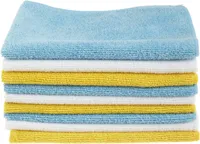Should you dust or vacuum first? This cleaning sequence is the only way you should tackle this task, say experts
Finding the correct cleaning sequence can mean the difference between a dust-free space and one that will encourage airborne allergies


Whether you tackling a deep clean, or only have a spare five minutes for a quick refresh, knowing whether to dust or vacuum first can shave time off your cleaning spree, so it is worth paying attention to how to get it right, so you can move on to more pleasurable activities.
Here, we have asked the experts for their top cleaning tips and advice on the correct cleaning sequence, so that you know whether you should dust or vacuum first, and can tackle this dreaded cleaning job in no time.
Should you dust or vacuum first?
Even if you're using the best vacuum or, even the best vacuum for pet hair, a few particles, pet dander, and debris are going to be missed. The dust that enters the air can settle in the smallest or most awkward-to-access places, which is why most cleaning professionals always recommend that you dust before you vacuum to help you capture as much as possible.
Dusting first is essential if it has been a considerable time since you last dusted. 'Always start with the highest point in your home when dusting,' says Millie Hurst, section editor of Homes & Gardens. 'The excess dust particles will often fall to the floor, in which case, your vacuum will pick up the remainder.'
Today's airtight high-tech vacuums with multiple filters (often a HEPA filter that traps at least 99.97 percent of particles of 0.3 microns) capture small dust particles efficiently, so if you're still wondering whether you should dust or vacuum first, you have your answer.
If you want to rid your home of dust particles, follow the step-by-step advice below for optimum results.

Millie Hurst is Section Editor at Homes & Gardens, overseeing the Solved section, which provides readers with practical advice for their homes. Millie has written about and tried out countless cleaning and DIY hacks in the six years since she became a journalist, and has worked in both London and New York.
1. Clear the clutter
The key to beating dust is to act quickly and often. Not only does dust make your house look and feel untidy but, more importantly, dust can seriously impact your health. Research published in the Epidemiology Journal suggests that exposure to indoor dust can lead to mucosal irritation. In simple terms, that means that you may feel congested, with more mucus, and sinus problems. It could also further trigger those who suffer from unknown dust allergies.
Design expertise in your inbox – from inspiring decorating ideas and beautiful celebrity homes to practical gardening advice and shopping round-ups.
To avoid this problem, it is advised that you clear the clutter regularly. The best way to achieve success is to work in small areas of the home first and work your way around, keeping a trash bag with you as you move from space to space.
This microfibre cloth from Amazon is a best-seller, and it comes in a pack of 24.
Amazon Basics Microfiber Cleaning Cloths | $13.29 at Amazon
These ultra-soft, non-abrasive microfiber cleaning cloths will not scratch paints, vinyl, glass, finishes, or other surfaces.
2. Start from the ceiling
Stating from the top of the room is the most efficient way to ensure that you capture as much dust as possible. Start by dusting and wiping hard-to-reach nooks and crannies, light fixtures, ceiling fans, tops of closets and shelving. Move down towards windowsills, chest of drawers, tabletops and baseboards. Continue to work your way down until you're satisfied that you've covered every surface.
3. Clean curtains
Knowing when and how to clean curtains is fundamental to stopping the spread of dusting, which is why it deserves special mention.
Just as with cleaning blinds, there isn’t one answer to the question of how to clean curtains. ‘The best way to clean your curtains depends on the material they’re made from,’ advises Mihalis Dimopoulos, founder of New York-based company, Lazy Susans Cleaning Service. This will determine the most effective way to look after them.
Heavy curtains are more cumbersome to take down but should be vacuumed frequently whilst still hung. Light, sheer curtains can be removed from the curtain rod and, in some cases, cleaned in a washing machine.
Make sure you regularly dust and vacuum your windowsills and floor coverings, too, as this will help keep your curtains clean. This is particularly important if you have pets. Lint rollers can work wonders for cleaning curtains as well. Just run them all the way down on both sides of the material to pick up any dirt, dust, and pet dander.
4. Vacuum the floor
Once the dust settles on the floor, now its the perfect time to vacuum. Don't be tempted to skip this step, you will only trample the dust and spread it throughout the house.
To get the best results, ensure all clutter is clear and the floor is clear and ready for a full vacuum clean. Often, vacuuming twice will capture the most dust. Work in a grid pattern until you've finished the entire area.

Jennifer is the Digital Editor at Homes & Gardens, bringing years of interiors experience across the US and UK. She has worked with leading publications, blending expertise in PR, marketing, social media, commercial strategy, and e-commerce. Jennifer has covered every corner of the home – curating projects from top interior designers, sourcing celebrity properties, reviewing appliances, and delivering timely news. Now, she channels her digital skills into shaping the world’s leading interiors website.
